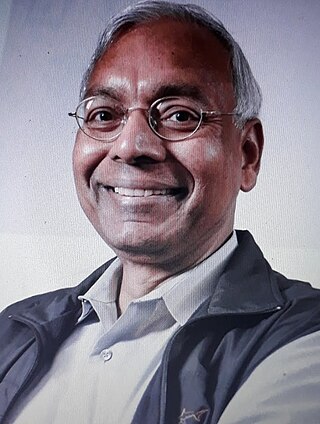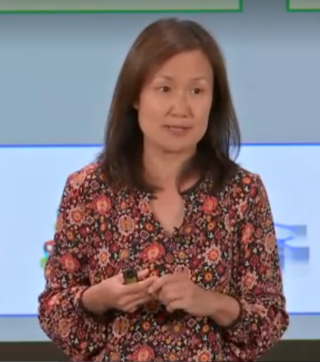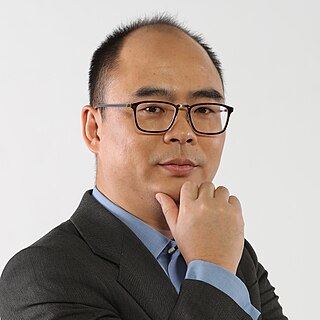
Handwriting recognition (HWR), also known as handwritten text recognition (HTR), is the ability of a computer to receive and interpret intelligible handwritten input from sources such as paper documents, photographs, touch-screens and other devices. The image of the written text may be sensed "off line" from a piece of paper by optical scanning or intelligent word recognition. Alternatively, the movements of the pen tip may be sensed "on line", for example by a pen-based computer screen surface, a generally easier task as there are more clues available. A handwriting recognition system handles formatting, performs correct segmentation into characters, and finds the most possible words.
Robert M. Haralick is Distinguished Professor in Computer Science at Graduate Center of the City University of New York (CUNY). Haralick is one of the leading figures in computer vision, pattern recognition, and image analysis. He is a Fellow of the Institute of Electrical and Electronics Engineers (IEEE) and a Fellow and past president of the International Association for Pattern Recognition. Professor Haralick is the King-Sun Fu Prize winner of 2016, "for contributions in image analysis, including remote sensing, texture analysis, mathematical morphology, consistent labeling, and system performance evaluation".

Thomas Shi-Tao Huang was a Chinese-born American computer scientist, electrical engineer, and writer. He was a researcher and professor emeritus at the University of Illinois at Urbana-Champaign (UIUC). Huang was one of the leading figures in computer vision, pattern recognition and human computer interaction.

Linda G. Shapiro is a professor in the Department of Computer Science and Engineering, a professor of electrical engineering, and adjunct professor of Biomedical Informatics and Medical Education at the University of Washington.
Object recognition – technology in the field of computer vision for finding and identifying objects in an image or video sequence. Humans recognize a multitude of objects in images with little effort, despite the fact that the image of the objects may vary somewhat in different view points, in many different sizes and scales or even when they are translated or rotated. Objects can even be recognized when they are partially obstructed from view. This task is still a challenge for computer vision systems. Many approaches to the task have been implemented over multiple decades.

Anastasios (Tas) Venetsanopoulos was a professor of electrical and computer engineering at Toronto Metropolitan University in Toronto, Ontario and a professor emeritus with the Edward S. Rogers Department of Electrical and Computer Engineering at the University of Toronto. In October 2006, Venetsanopoulos joined what was then Ryerson University and served as the founding vice-president of research and innovation. His portfolio included oversight of the university's international activities, research ethics, Office of Research Services, and Office of Innovation and Commercialization. He retired from that position in 2010, but remained a distinguished advisor to the role. Tas Venetsanopoulos continued to actively supervise his research group at the University of Toronto, and was a highly sought-after consultant throughout his career.
Bir Bhanu is the Marlan and Rosemary Bourns Endowed University of California Presidential Chair in Engineering, the Distinguished Professor of Electrical and Computer Engineering, and Cooperative Professor of Computer Science and Engineering, Mechanical Engineering and Bioengineering, at the Marlan and Rosemary Bourns College of Engineering at the University of California, Riverside (UCR). He is the first Founding Faculty of the Marlan and Rosemary Bourns College of Engineering at UCR and served as the Founding Chair of Electrical Engineering from 1/1991 to 6/1994 and the Founding Director of the Center for Research in Intelligent Systems (CRIS) from 4/1998 to 6/2019. He has been the director of Visualization and Intelligent Systems Laboratory (VISLab) at UCR since 1991. He was the Interim Chair of the Department of Bioengineering at UCR from 7/2014 to 6/2016. Additionally, he has been the Director of the NSF Integrative Graduate Education, Research and Training (IGERT) program in Video Bioinformatics at UC Riverside. Dr. Bhanu has been the principal investigator of various programs for NSF, DARPA, NASA, AFOSR, ONR, ARO and other agencies and industries in the areas of object/target recognition, learning and vision, image/video understanding, image/video databases with applications in security, defense, intelligence, biological and medical imaging and analysis, biometrics, autonomous navigation and industrial machine vision.

Anil Kumar Jain is an Indian-American computer scientist and University Distinguished Professor in the Department of Computer Science & Engineering at Michigan State University, known for his contributions in the fields of pattern recognition, computer vision and biometric recognition. He is among the top few most highly cited researchers in computer science and has received various high honors and recognitions from institutions such as ACM, IEEE, AAAS, IAPR, SPIE, the U.S. National Academy of Engineering, the Indian National Academy of Engineering and the Chinese Academy of Sciences.

Jianying Hu is a Chinese-American computer scientist at the IBM Thomas J. Watson Research Center, Yorktown Heights, NY, USA, known for her work in data mining, machine learning, artificial intelligence and health informatics. She is an IBM Fellow, Global Science Leader of AI for Healthcare and Director of Healthcare and Life Sciences Research at IBM. She is also an Adjunct Professor in the Department of Medicine at the Icahn School of Medicine at Mount Sinai. She has published over 150 scientific papers and holds more than 50 patents.
Tin Kam Ho is a computer scientist at IBM Research with contributions to machine learning, data mining, and classification. Ho is noted for introducing random decision forests in 1995, and for her pioneering work in ensemble learning and data complexity analysis. She is an IEEE fellow and IAPR fellow.

Gang Hua is a Chinese-American computer scientist who specializes in the field of computer vision and pattern recognition. He is an IEEE Fellow, IAPR Fellow and ACM Distinguished Scientist. He is a key contributor to Microsoft's Facial Recognition technologies.
Xiaoqing Ding is a Chinese electric engineer and a professor and the PhD Supervisor of the Department of Electronic Engineering at Tsinghua University in Beijing. She focuses on the fields of facial recognition and multilingual character and document recognition with such languages as Chinese, Japanese, Korean, Mongolian, Tibetan, Uighur, Arabic, and English. Her technologies have been marketed to many large companies, such as Microsoft Office, and are used worldwide.

Josiane Zerubia is a French research scientist. She is the Director of Research at INRIA (DRCE), Université Côte d'Azur. Dr. Zerubia has made pioneering research contributions. She has been the Principal Investigator of numerous projects like of the Ayin (2012-2016), the Ariana (1998-2011) and of the Pastis (1995-1997). Presently, she is leading as head of the Ayana exploratory project (2020-2023). She has been professor (PR1) at SUPAERO (ISAE) in Toulouse since 1999.
Mark S. Nixon is an author, researcher, editor and an academic. He is the former president of IEEE Biometrics Council, and former vice-Chair of IEEE PSPB. He retired from his position as Professor of Electronics and Computer Science at University of Southampton in 2019.
Yao Wang is a Chinese-American video engineer whose research topics include networked video, video coding, computer vision, medical imaging, and the use of machine learning techniques to diagnose lymphedema and concussions. She is a professor of electrical and computer engineering and of biomedical engineering in the New York University Tandon School of Engineering, where she is also Associate Dean for Faculty Affairs and holds an affiliated faculty position in the Radiology Department of the New York University Grossman School of Medicine. She is also a member of NYU WIRELESS.
Minerva Yeung is an American research scientist and educator best known for her work in video processing, multimedia information systems, and digital watermarking.
Gunilla Borgefors is a Swedish computer scientist specializing in image processing, including distance transforms, topological skeletonization, and edge detection. She is a professor emerita in the Department of Information Technology at Uppsala University, associated with the Centre for Image Analysis.
Zhen Jane Wang is a Chinese-Canadian signal processing researcher whose research includes work on statistical signal processing, image fusion, digital video fingerprinting, biological network inference, and deep learning. She is a professor in the Department of Electrical and Computer Engineering at the University of British Columbia, and the editor-in-chief of IEEE Signal Processing Letters.
Yingli Tian is a Chinese-American electrical engineer known for her research applying image processing to the analysis of facial expressions and their meanings. Her more recent research has focused on assistive technology including the automated recognition of sign language. She is CUNY Distinguished Professor in the Department of Electrical Engineering at the City College of New York.
Junping Du is a Chinese computer scientist with highly varied research interests including publications on image restoration, crowdsourced face recognition, document summarization, distributed consensus, computational trust, virtualization in Hadoop-based distributed computation, multi-agent systems, state estimation for tracking mobile robots, training of neural networks, signal processing using Kalman filters, and robust control for automated vehicles. She is a professor of computer science at the Beijing University of Posts and Telecommunications.







